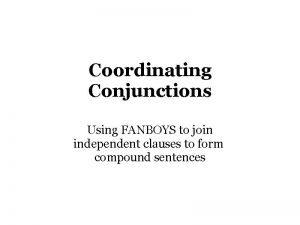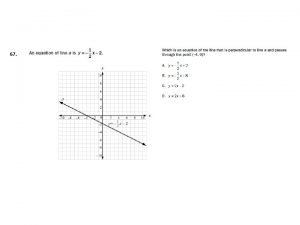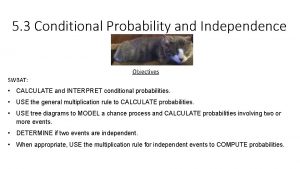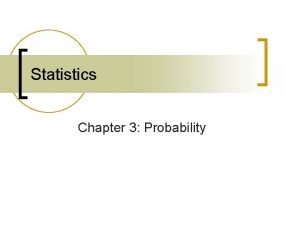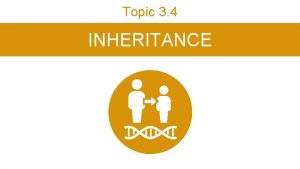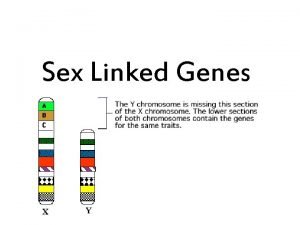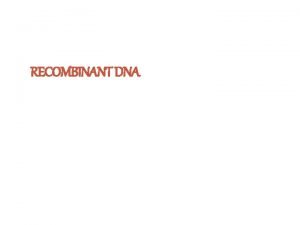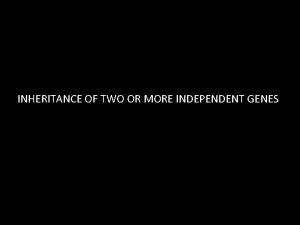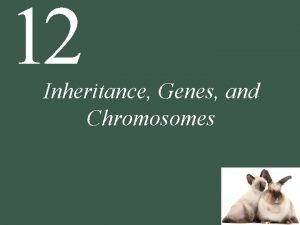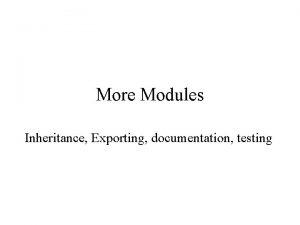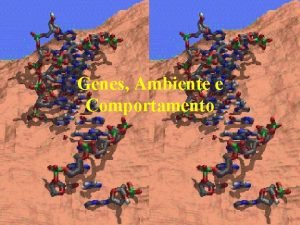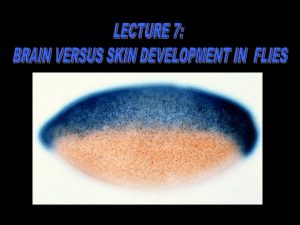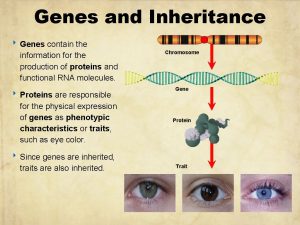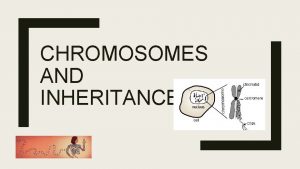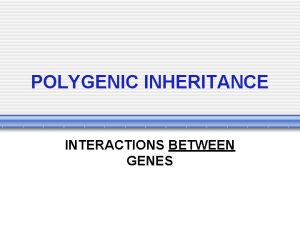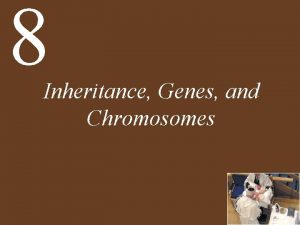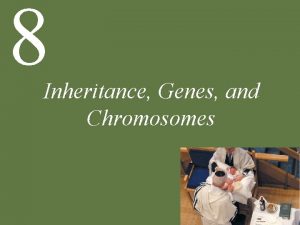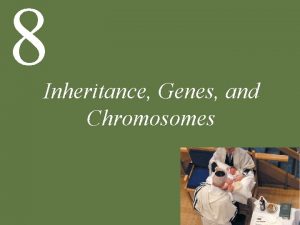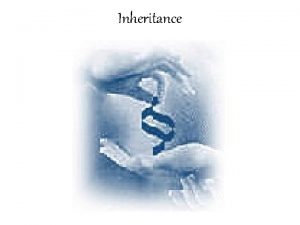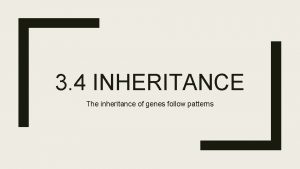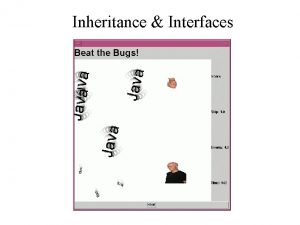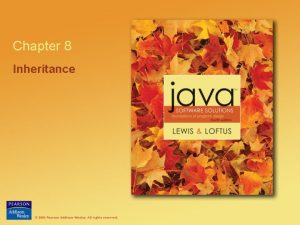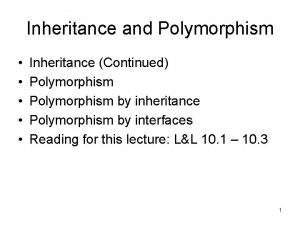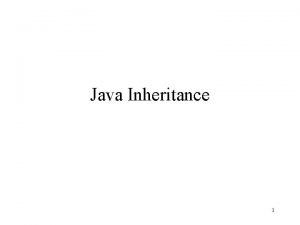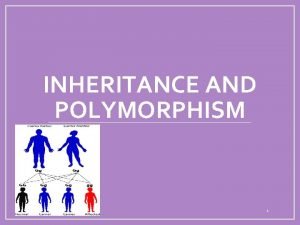INHERITANCE OF TWO OR MORE INDEPENDENT GENES In





























- Slides: 29

INHERITANCE OF TWO OR MORE INDEPENDENT GENES

In Drosophila melanogaster, body colour is determined by the e gene: the recessive allele is responsible for the black colour of the body, the dominant allele e+ is responsible for the grey body. Vestigial wings are determined by the recessive allele vg, normal wings are determined by the dominant allele vg+. These two genes are independent. If dihybrid flies for these two genes are crossed and resulting progeny is composed by 368 individuals, how many individuals are present in every phenotypic class? e+ e+ ee vg+ vg vg Parental Genotypes: e+e vg+vg X e+e vg+vg e+ (1/2) Gametes e (1/2) vg+ (1/2) e+ vg+ (1/4) vg (1/2) e+ vg (1/4) vg+ (1/2) e vg+ (1/4) vg (1/2) e vg (1/4)

Phenotypes for gene e Phenotypes for gene vg Phenotipical classes (cross e+e X e+e) (cross vg+vg X vg+vg) vg+ (3/4) e+ (3/4) vg (1/4) e+ vg+ (¾ X ¾= 9/16) e+ vg (¾ X ¼ = 3/16) vg+ (3/4) e vg + (¾ X ¼ = 3/16) vg (1/4) e vg (¼ X ¼=1/16) e (1/4) 9/16 di 368 = 207 individuals e+ vg+ brown body and normal wings 3/16 di 368 = 69 individuals e+ vg brown body and vestigial wings 3/16 di 368 = 69 individuals e vg+ black body and normal wings 1/16 di 368 = 23 individuals e vg black body and vestigial wings

In guinea pigs, the R gene determinates fur rough or smooth, while the B gene controls fur color. Determine the genotype of individuals used for the crosses and verify your hypothesis with χ2 test. n° of individuals in the progeny Phenotype of individuals used for the cross Black Rough Black Smooth Brown Rough Brown Smooth a) Black Rough X Brown Smooth 50 0 b) Black Rough X Black Rough c) Black Rough X Brown Smooth d) Brown Rough X Black Rough a)The parents have different phenotypes and the progeny is all Black and Rough: - Black and Rough are dominant characters (B, black; R, rough) - The parents are homozygous: BB RR X bb rr We do not perfomed statistic test because we do not have differences between expected progeny and observed progeny.

In guinea pigs, the R gene determinates fur rough or smooth, while the B gene controls fur color. Determine the genotype of individuals used for the crosses and verify your hypothesis with χ2 test. n° of individuals in the progeny Phenotype of individuals used for the cross Black Rough Black Smooth Brown Rough Brown Smooth a) Black Rough X Brown Smooth 50 0 b) Black Rough X Black Rough 185 60 57 18 c) Black Rough X Brown Smooth d) Brown Rough X Black Rough b) We know that Black and Rough are dominant traits. The crossed individuals have the same phenotypes but in the progeny we have the recessive characters, thus both parents are double heterozygous: Bb Rr X Bb Rr In the progeny we excpect: 9/16 BR (Black rough): 3/16 Br (black smooth): 3/16 b. R (brown rough): 1/16 br (brown smooth)

c 2 Phenotypes Xo (observed individuals) H (hypothesi s) Xa Expected individuals Black Rough 185 9/16 Black Smooth 60 Brown Rough (Xo –Xa)2 Xa 180 (185 -180) 2= 25 25/180= 0, 14 3/16 60 0 0/60= 0 57 3/16 60 (57 -60) 2= 9 9/60=0, 15 Brown Smooth 18 1/16 20 (18 -20) 2= 4 4/20= 0, 20 Total 320 16/16 320 c 2 = 0, 49 Freedom Degree= 4 – 1 = 3 S =0, 49

Accepted P >90%, we accept the hypotesis Rejected

In guinea pigs, the R gene determinates fur rough or smooth, while the B gene controls fur color. Determine the genotype of individuals used for the crosses and verify your hypothesis with χ2 test. n° of individuals in the progeny Phenotype of individuals used for the cross Black Rough Black Smooth Brown Rough Brown Smooth a) Black Rough X Brown Smooth 50 0 b) Black Rough X Black Rough 185 60 57 18 c) Black Rough X Brown Smooth 105 100 98 97 d) Brown Rough X Black Rough c) The parents have different phenotypes. The second parent is homozygous recessive for both genes (bb rr). The first parent has the dominant phenotypes for both characters B - R -. In the progeny we observe classes of individuals with recessive phenotypes thus the first indiviudual id double heterozygous: Bb Rr. In the progeny we expect 4 phenotypic classes with ratio:

c 2 Phenotypes Xo (observed individuals) H (hypothes is) Xa Expected individuals Black Rough 105 ¼ Black Smooth 100 Brown Rough (Xo –Xa)2 Xa 100 (105 -100) 2= 25 25/100= 0, 25 ¼ 100 0 0/60= 0 98 ¼ 100 (98 -100) 2= 4 4/100=0, 04 Brown Smooth 97 ¼ 100 (97 -100) 2= 9 9/100= 0, 09 Total 400 4/4 400 c 2 = 0, 38 Freedom Degree = 4 – 1 = 3 P =>90%, we accept the hypothesis S =0, 38

In guinea pigs, the R gene determinates fur rough or smooth, while the B gene controls fur color. Determine the genotype of individuals used for the crosses and verify your hypothesis with χ2 test. n° of individuals in the progeny Phenotype of individuals used for the cross Black Rough Black Smooth Brown Rough Brown Smooth a) Black Rough X Brown Smooth 50 0 b) Black Rough X Black Rough 185 60 57 18 c) Black Rough X Brown Smooth 105 100 98 97 d) Brown Rough X Black Rough 63 17 58 22 d) The first individual is homozygous recessive for color (bb) and he has the dominant phenotype for Rough gene (R -). The second individual is dominant for both characters (B - R -). In the progeny we observe the classes with recessive phenotypes for brown ans smooth hair, thus the original individuals have a recessive allele to donate to the progeny: b b R r X B b R r

With branch diagram determine expected phenotypic classes: Gene B bb X Bb B (1/2) b (1/2) Gene R Rr x Rr phenotypic Classes R (3/4) B R (1/2 x 3/4 = 3/8) black rough r (1/4) B r (1/2 x 1/4 = 1/8) black smooth R (3/4) b R (1/2 x 3/4 = 3/8) brown rough r (1/4) b r (1/2 x 1/4 = 1/8) brown smooth

c 2 Phenotyp Xo es (observed individual s) H Xa (hypoth Expected esis) individuals (Xo –Xa)2 Xa Nero arruffato 63 3/8 60 (63 -60) 2= 9 9/60= 0, 15 Nero liscio 17 1/8 20 (17 -20) 2= 9 9/20= 0, 45 Bruno arruffato 58 3/8 60 (58 -60) 2= 4 4/60=0, 07 Bruno liscio 22 1/8 20 (22 -20) 2= 4 4/20= 0, 2 Totale 160 8/8 160 c 2 = 0, 87 Degrees of freedom = 4 – 1 = 3 P =80 -90%, we accept the hypothesis S =0, 87

Determine the genotype of individuals used for the crosses and verify your hypothesis with χ2 test. For each cross create a table, according to the scheme reported below. Gene W determines Red color, gene D determines the plant height Numero di individui della progenie Phenotype of individuals used for Red White the cross tall short 120 0 45 0 a) red tall x red tall b) red tall x white short c) red tall x white short d) white tall x e) red tall x red tall a) Color: the crossed individuals have the same phenotypes but in the progeny we have also recessive phenotype individuals: both parents are heterozygous (Ww) and Red (W) is dominant over white (w). b) Height: we cannot establish wich is the dominant allele since the character does not segregate. All the progeny is tall. Both parents could be recessive (dd) or D D x D - o or D - x D D

c 2 Phenotypes Xo H (observed (hypothes individuals) is) Xa Expected individuals (Xo –Xa)2 Xa Red tall 120 3/4 123, 75 (120 -123, 75) 2= 14 14/123, 75= 0, 11 White tall 45 1/4 41, 25 (45 -41, 25) 2= 14 14/41, 25= 0, 33 Total 165 4/4 165 c 2 = 0, 44 Degrees of freedom= 2 – 1 = 1 P =50 -70%, we can accept the hypothesis S =0, 44

Determine the genotype of individuals used for the crosses and verify your hypothesis with χ2 test. For each cross create a table, according to the scheme reported below. Gene W determines Red color, gene D determines the plant height n° of individuals in the progeny Phenotype of individuals used for Red White the cross tall short tall 120 0 45 a) red tall x red tall b) red tall x white short c) red tall x white short d) white tall x e) red tall x 100 0 105 White short 0 0 red tall b) The crossing plants have two different phenotypes. In the progeny we observe plants red and white: we know that red is dominant over white thus the genotypes are W w X w w Height: since we have only tall plants we estabish that tall is dominant over short. In the progeny there isn’t segregation of character then the tall plant is homozygous. The genotypes are: D D X d d

Ww DD X ww dd We expect: ½ WD (red and tall) and ½ w. D (white and tall). Verifichiamo con il test del c 2 se possiamo accettare l’ipotesi. Phenotype s Xo (observed individuals) H (hypothes is) Xa Expected individuals Red tall 100 ½ White tall 105 Total 205 (Xo –Xa)2 Xa 102, 5 (100 -102, 5) 2= 6, 25/102, 5= 0, 06 ½ 102, 5 (105 -102, 5) 2= 6, 25/102, 5= 0, 06 2/2 205 c 2 = 0, 12 Degrees of freedom = 2 – 1 = 1 P = 70 -80%, we accept the hypothesis S =0, 12

Determine the genotype of individuals used for the crosses and verify your hypothesis with χ2 test. For each cross create a table, according to the scheme reported below. Gene W determines Red color, gene D determines the plant height n° of individuals in the progeny Phenotype of individuals used for Red White the cross tall short tall 120 0 45 a) red tall x red tall White short 0 b) red tall x white short 100 0 105 0 c) red tall x white short 45 43 48 44 d) white tall x e) red tall x red tall c) The crossed plants have different phenotypes. In the progeny we observed segregation of the character: we know that red is dominant over white and we assess that the cross is between a heterozygous and a homozygous recessive: W w X w w Height: Tall is dominant over short thus also for height the cross is between a heterozygous and a homozygous recessive D d X d d

Ww. Dd X wwdd We expect 4 phenotypic classes with ratio 1 : 1 : 1. test c 2 Phenotypes Xo (observed individuals) H (hypothes is) Xa Expected individuals Red tall 45 ¼ Red short 43 White tall (Xo –Xa)2 Xa 45 (45 -45) 2= 0 0/45= 0 ¼ 45 (43 -45) 2= 4 4/45= 0, 09 48 ¼ 45 (48 -45) 2= 9 9/45=0, 2 White short 44 ¼ 45 (44 -45) 2= 1 1/45= 0, 02 Total 180 4/4 180 c 2 = 0, 31 Degrees of freedom = 4 – 1 = 3 P =>90%, we can accept the hypothesis S =0, 31

Determine the genotype of individuals used for the crosses and verify your hypothesis with χ2 test. For each cross create a table, according to the scheme reported below. Gene W determines Red color, gene D determines the plant height n° of individuals in the progeny Phenotype of individuals used for Red White the cross tall short tall 120 0 45 a) red tall x red tall White short 0 b) red tall x white short 100 0 105 0 c) red tall x white short 45 43 48 44 red tall 175 67 182 58 d) white tall x e) red tall x red tall d) In the progeny we have recessive phenotypic classes. We can suppose that the cross is between: w w D d X W w D d

What are phenotypic classes expected ? Gene W ww X Ww W (1/2) w (1/2) Gene D Dd x Dd Phenotypic classes D (3/4) W D (1/2 x 3/4 = 3/8) Red Tall d(1/4) W d (1/2 x 1/4 = 1/8) Red short D (3/4) w D (1/2 x 3/4 = 3/8) White Tall d (1/4) w d (1/2 x 1/4 = 1/8) White short We expect 4 phenotypic classes: 3/8 : 1/8

Phenotype s Xo (observed individuals) H (hypothes is) Xa Expected individuals Red tall 175 3/8 Red short 67 White tall (Xo –Xa)2 Xa 180, 75 (175 -180, 75) 2= 33, 06 /180, 75= 0, 18 1/8 60, 25 (67 -60, 25) 2= 45, 56 /60, 25= 0, 75 182 3/8 180, 75 (182 -180, 75) 2= 1, 56/180, 75=0, 1 White short 58 1/8 60, 25 (58 -60, 25) 2= 5, 06/60, 25= 0, 08 Total 482 8/8 482 c 2 = 0, 31 Degrees of freedom = 4 – 1 = 3 P =70 -80%, Hypothesis accepted S =1, 11

Determine the genotype of individuals used for the crosses and verify your hypothesis with χ2 test. For each cross create a table, according to the scheme reported below. Gene W determines Red color, gene D determines the plant height n° of individuals in the progeny Phenotype of individuals used for Red White the cross tall short tall 120 0 45 a) red tall x red tall White short 0 b) red tall x white short 100 0 105 0 c) red tall x white short 45 43 48 44 red tall 175 67 182 58 265 92 93 28 d) white tall x e) red tall x red tall e)In the progeny we observe recessive phenotypes. The individuals must be double heterozygous: W w D d X W w D d From a dihybrid cross we expect 4 phenotipic classes: 9/16 WD (Red tall) : 3/16 Wd (Red short) : 3/16 w. D (white tall) : 1/16 wd (white short).

Phenotypes Xo (observed individuals) H (hypothes is) Xa Expected individuals Red tall 265 9/16 Red short 92 White tall (Xo –Xa)2 Xa 268, 87 (265 -268, 87) 2= 14, 97 /268, 87= 0, 05 3/16 89, 62 (92 -89, 62) 2= 5, 66 /89, 62= 0, 06 93 3/16 89, 62 (93 -89, 62) 2= 11, 42/89, 62=0, 12 White short 28 1/16 29, 87 (28 -29, 87) 2= 3, 49/29, 87= 0, 11 Total 478 16/16 478 c 2 = 0, 34 Degrees of freedom = 4 – 1 = 3 P >90%, hypothesis accepted S =0, 34

Crossing a pure line of melons white and spherical fruits with an other pure line of melons with yellow and flat fruits the f 1 progeny is melons with white and spherical fruits. P 1 RR GG X P 2 rr gg Rr Gg F 1 Crossing two plants of F 1 we have: 148 Plants with white and spherical fruits F 2 52 Plants with yellow and spherical fruits 49 Plants with white and flat fruits 23 Plants with yellow and flat fruits Determine the genotypes of individuals of P 1, P 2 e F 1, make the hypothesis of traits segregation and verify the results with X 2 From first cross we know that spherical is dominant over flat and white is dominant over yellow. WE decide to name R the gene that control the shape melon and G the gene that control the color melon: the first parents is homozygous dominant and the second parent is homozygous recessive. The progeny will be heterozygous for both genes.

In F 2 we have 4 phenotipic classes. This is a dihybrid cross and we expect frequencies 9 : 3 : 1. test c 2. Phenotypes Xo (observed individuals) H (hypothes is) Xa Expected individuals White Spherical 148 9/16 Yellow Spherical 52 White Flat (Xo –Xa)2 Xa 153 (148 -153) 2= 25 25 /153= 0, 16 3/16 51 (52 -51) 2= 1 1 /51= 0, 02 49 3/16 51 (49 -51) 2= 4 4/51=0, 08 Yellow Flat 23 1/16 17 (23 -17) 2= 36 36/17= 2, 12 Total 272 16/16 272 c 2 = 2, 38 Degrees fo freedom = 4 – 1 = 3 P=30 -50%, hypothesis accepted S =2, 38

Using the branch diagram, determine the gametes produced by individuals with the following genotype (A, B and C genes are independent): a) Aa Bb CC Gene A Aa Gene B Bb Gene C CC Gametes B (1/2) C (1) ABC (½ X 1= 1/4) b (1/2) B (1/2) C (1) Ab. C (½ X 1= 1/4) a. BC (½ X 1= 1/4) b (1/2) C (1) ab. C (½ X 1= 1/4) A (1/2) a (1/2)

b) Aa bb Cc Dd Gene A Aa A (1/2) Gene B bb b (1) Gene C Cc C (1/2) c (1/2) a (1/2) b (1) C (1/2) c (1/2) Gene D Dd Gametes D (1/2) Ab. CD (½ X 1 X ½ = 1/8) d (1/2) D (1/2) Ab. Cd (½ X 1 X ½ = 1/8) Abc. D (½ X 1 X ½ = 1/8) d (1/2) D (1/2) Abcd (½ X 1 X ½ = 1/8) ab. CD (½ X 1 X ½ = 1/8) d (1/2) D (1/2) ab. Cd (½ X 1 X ½ = 1/8) abc. D (½ X 1 X ½ = 1/8) d (1/2) abcd (½ X 1 X ½ = 1/8)

c) Aa Bb Cc Gene A Aa Gene B Bb B (1/2) A (1/2) b (1/2) a (1/2) B (1/2) b (1/2) Gene C Cc Gametes C (1/2) ABC (½ X ½ = 1/8) c (1/2) C (1/2) ABc (½ X ½ = 1/8) Ab. C (½ X ½ = 1/8) c (1/2) C (1/2) Abc (½ X ½ = 1/8) a. BC (½ X ½ = 1/8) c (1/2) C (1/2) a. Bc (½ X ½ = 1/8) ab. C (½ X ½ = 1/8) c (1/2) abc (½ X ½ = 1/8)

For the following cross, determine the phenotypic classes expected in the progeny and their frequencies (A, B and C genes are independent) Aa. Bb. Cc x aabbcc Phenotypes for Gene C Gene A Gene B Cc X cc Aa X aa Bb X bb C (1/2) B (1/2) c (1/2) A (1/2) C (1/2) b (1/2) c (1/2) C (1/2) B (1/2) a (1/2) c (1/2) C (1/2) b (1/2) c (1/2) Final Phenotypes ABC (½ X ½ = 1/8) ABc (½ X ½ = 1/8) Ab. C (½ X ½ = 1/8) Abc (½ X ½ = 1/8) a. BC (½ X ½ = 1/8) a. Bc (½ X ½ = 1/8) Ab. C (½ X ½ = 1/8) Abc (½ X ½ = 1/8)
 Lirik lagu more more more we praise you
Lirik lagu more more more we praise you More more more i want more more more more we praise you
More more more i want more more more more we praise you Linked genes and unlinked genes
Linked genes and unlinked genes Genepattern
Genepattern Polygenic inheritance
Polygenic inheritance Two main clauses
Two main clauses The more you take the more you leave behind
The more you take the more you leave behind The more you study the more you learn
The more you study the more you learn Aspire not to
Aspire not to Examples of newton's first law
Examples of newton's first law Knowing more remembering more
Knowing more remembering more The more i give to thee the more i have
The more i give to thee the more i have More choices more chances
More choices more chances Human history becomes more and more a race
Human history becomes more and more a race Independent events statistics
Independent events statistics How to tell if two events are independent
How to tell if two events are independent Independent clause in compound sentence
Independent clause in compound sentence How to tell if two events are independent
How to tell if two events are independent Comma before and
Comma before and Independent practice lesson 2 solve two step equations
Independent practice lesson 2 solve two step equations Uji median dengan spss
Uji median dengan spss Two independent sample t test spss
Two independent sample t test spss Varying sentence structures
Varying sentence structures Independent probability formula
Independent probability formula Dependent probability formula
Dependent probability formula Mutagens
Mutagens Sex-linked traits examples
Sex-linked traits examples Stabilizing selection human birth weight
Stabilizing selection human birth weight Complementary genes example
Complementary genes example Blood type punnett square with rh factor
Blood type punnett square with rh factor





